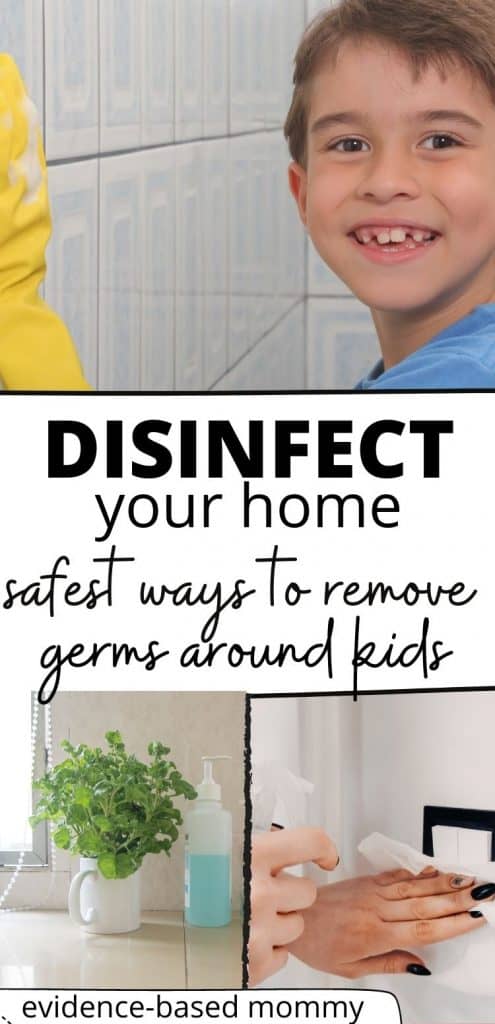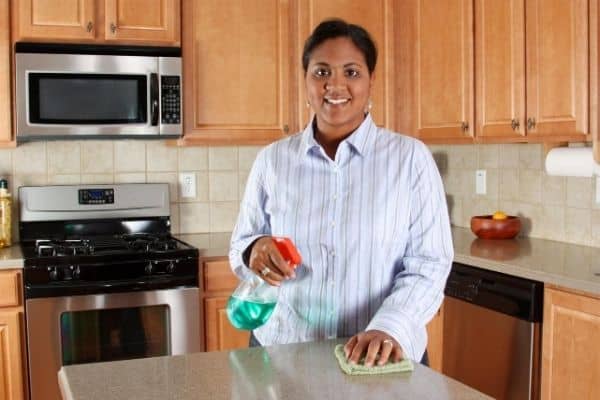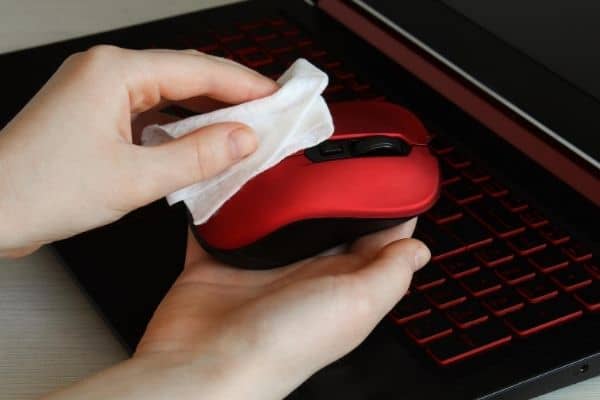Parents have their work cut out for them when keeping their home clean. It’s not just enough to keep everything neat and tidy; it is also critical that it is free of harmful disease-causing germs. With that said, it’s important to understand the difference between disinfecting and cleaning.
That’s why we’re going to look at how to disinfect your home effectively and safely while avoiding toxic chemicals.
Table of Contents
What’s the difference between cleaning and disinfecting?
On the surface, cleaning and disinfecting seem very similar. After all, both make your home nicer for you and your family, and they both reduce the risk of getting sick while improving home air quality.

But it is critical to recognize that cleaning is not enough to guarantee a safe and healthy home. Most cleaners don’t effectively kill germs.
In fact, “cleaning” can actually spread germs and contamination if you’re not careful. Tools you use, such as cleaning rags and brushes, can take germs from one area of your home to another.
Being aware of the difference between cleaning and disinfecting helps you determine the right products to use for both cleaning and disinfecting.
Remember, there are cleaning products out there that are not potent enough to disinfect. Meanwhile, there are disinfecting products that require prior cleaning in order to maximize their potency, such as disinfecting wipes.
With that said, read on to learn how to clean your home after illness, like the flu or a stomach bug, strikes.
Why it’s important to clean before disinfecting
It is much easier to disinfect a surface after you clean and organize it. For example, it’s very difficult to kill germs on a countertop when there’s clutter all over it. Here’s what I suggest to help make your disinfection process more efficient:
Organize before you clean
The first step to disinfecting is to organize things. Anything that doesn’t belong somewhere must be returned to its rightful place. That means toys put away, stuff taken off the counter, clothes in the hamper… you get the idea.

A few strategically-placed “swoop baskets” can help make the process easier. Basically, if you need to do a cleaning quickly, the baskets will let you just toss stuff in them to organize later.
Of course, you may need to do a declutter if you’re struggling to find a place to put everything. Fortunately, I have some resources to help.
RELATED: 5 Day Toy Declutter Master Plan
RELATED: 4 Easy steps to decluttering your closet
Clean before you disinfect
After tidying up the first layer of clutter, it helps to clean dust, dirt, and grime before trying to disinfect. That’s because germs can live in the “crud” on surfaces, and disinfectants may not be able to penetrate through grime.

This block contains unexpected or invalid content.ResolveConvert to HTML
You can use an all-purpose cleaner (my family loves this one) or simply mix half vinegar, half water with a few drops of dish soap. Both are great for kitchen countertops, table tops, and more (but the homemade one doesn’t cut through grease quite as easily).
How to disinfect your home
Finally, there are circumstances that might require you to go beyond cleaning. Disinfecting is a process done to eliminate as many germs from anything as possible.
While disinfecting should be done on a regular basis, it is more critical if you’re concerned about contamination, such as after working with raw poultry at your kitchen counter.
Different disinfecting products are rated based on how which germs they can kill, so make sure you look carefully at labels before choosing a disinfectant. If you need help choosing a disinfectant, the EPA has lists of registered disinfectants based on specific bacteria and viruses (this one is both effective and listed as safe by the Environmental Working Group.
What is disinfection?
As mentioned, disinfection is a process done to eliminate germs. Depending on your cleaning method and the disinfecting product used, it can eliminate as much as 99.99% of germs.
Top areas of the home to disinfect
Ideally, you can disinfect every part of your home. But let’s face it: Most of us lead very hectic lives. Hence, here are the top areas that you should at least cover and focus on given their high-touch and high-risk status of contamination:

- The kitchen. This is where you prepare food and is thus the heart of your home’s health and nutrition. Unfortunately, it is also constantly exposed to contaminants that can be found from raw ingredients and improper food handling.
Kitchen appliances also prove to be the most handled objects in homes. It is both ridiculous and scary how many germs might be thriving on your coffee maker or fridge handles.
How to disinfect your kitchen: We recommend using disinfecting products specially formulated for kitchen use (Note: Vinegar is not a disinfectant and won’t effectively kill germs).
Bleach diluted with water is a common disinfectant that’s easy to find, but you have to be careful with it. NEVER use vinegar and bleach together since they can chemically react to create toxic (potentially deadly) fumes. NEVER mix bleach with anything except water. Make sure you have plenty of ventilation when you use bleach. If you’re pregnant, let someone else do the disinfecting around the home if possible.
And if you’re worried about the safety of bleach when you have kids, I get it! I want to avoid toxic chemicals in my home too.
But here’s the thing: Generally speaking, bleach only causes respiratory effects (such as asthma) when you have day-in, day-out contact with it for months or years at a time. Using it weekly for disinfection (assuming you follow safety rules and DO NOT MIX BLEACH with anything but water) is unlikely to cause chronic health effects.
Thymol is a great natural alternative to bleach for disinfecting. These wipes from Seventh Generation have thymol as their active ingredient.
- Knobs and Switches. Other high-touch areas are doorknobs, light switches, and remote controls. Make sure to prioritize them in your disinfection routines. Disinfectant wipes are the way to go on these objects.
- Personal Items. Finally, don’t forget to disinfect your personal items. These include your digital devices, computer peripherals (including the mouse and keyboard), keys, and pens.
- Remote Controls. Go beyond your television’s remote control and include other high-touch appliance accessory or keypad that is frequently touched or handled throughout the day like your thermostat, telephone dial, and appliance buttons.
- Things Exposed to Respiratory Droplets. These include headphones, other ear and mouthpieces, and other items that usually come in close proximity with your eyes, ears, nose, and mouth.
- Your Kid’s Toys. Finally, don’t forget your children’s favorite things, such as learning manipulatives, gaming console controllers, building blocks, and others.
These are things that we frequently use every single day regardless if we wash our hands or not, and are thus more likely to harbor germs.

How to disinfect knobs, switches, and personal items: Disinfecting wipes are very easy to use when it comes to wiping down high-touch surfaces more frequently. Keep a stash near these areas to serve as a constant reminder.
How often should I disinfect my home?
Disinfecting should definitely be done on a regular basis, but it is more critical to do if someone in the family just got sick, or someone recently went to a high-risk place.
If someone just had a stomach bug, the flu, or another illness in your home, make sure to disinfect extra thoroughly!
Don’t forget your hands
Finally, don’t just focus on objects and surfaces alone. If there are parts in your home that must always stay clean, those should be your hands.
Place a hand sanitizing station right by the front door. Put up a reminder to wash hands (with soap and water for 20 seconds) near the kitchen sink, and place another one by the bathroom sink.
If you have school-age kids, it’s imperative that you keep them from bringing germs home from school. Have them wash their hands as soon as they come in, and minimize germ carryover by keeping shoes, backpacks, and other school items near the door.
If your child has homework, make sure they don’t carry pencils, crayons, or other supplies between school and home. And it might be wise to have disinfecting wipes at their work space so they can clean their pencil when they’re done with studies.
Conclusions on disinfecting your home
Germs can spread disease, the fact is, you can’t escape them.
However, you can reduce your family’s exposure to harmful bacteria and viruses through disinfecting. You should regularly sanitize and disinfect your home regularly as part of your cleaning routine. Focus on areas that receive more handling and traffic than others like light switches, doorknobs, remote controls, and others.
Fortunately, there are products that can safely disinfect surfaces throughout your home while minimizing toxic chemical exposure.
Through a diligent cleaning routine that involves sanitizing and disinfecting practices as well, we are confident that you will be able to protect your family from disease-causing germs for a happier and healthier life.
This post is contributed by Mariam N., a hygiene expert working with Sono Supplies. She has been interested in health and cleaning issues since she was young and wants to share her knowledge and experience with others who are not indifferent to clean-up. Mariam is deeply convinced that house cleaning is a critical part of hygiene. On a regular basis, she delivers expert cleaning advice on how to disinfect and clean tools and surfaces in the home and the medical field.
